The Impact of Variable Horizon Shade on the Growing Season Energy Budget of a Subalpine Headwater Wetland
Abstract
1. Introduction
2. Study Site
3. Materials and Methods
3.1. Meteorological Data
3.2. Eddy Covariance Measurements
3.3. Horizon Shade Model
3.4. Solar Radiation Model
3.5. Shade and Seasonal Phases
3.6. Statistical Analysis
4. Results
4.1. Spatial and Temporal Patterns of Horizon Shade
4.2. Growing Season Surface Energy Budget of a Shaded Subalpine Wetland
4.3. Influence of Horizon Shade on Wetland’s K↓, Microclimate and Energy Budget
4.3.1. Effect of Horizon Shade on Incoming Solar Radiation
4.3.2. Effect of Horizon Shade on Site’s Climatic Conditions
4.3.3. Effect of Horizon Shade on Site’s Surface Energy Budget and Implications for ET
5. Discussion
5.1. Temporal and Spatial Patterns of Shade
5.2. Growing Season Subalpine Wetland Surface Energy Trends
5.3. Impact of Horizon Shade on Incoming Solar Radiation, Microclimate and the Energy Budget
6. Conclusions
Supplementary Materials
Author Contributions
Funding
Institutional Review Board Statement
Informed Consent Statement
Data Availability Statement
Acknowledgments
Conflicts of Interest
References
- Lininger, H.; Weingartner, R.; Grosejean, M. Mountains of the World: Water Towers for the 21st Century. In Proceedings of the United Nations Commission on Sustainable Development, New York, NY, USA, 20 April–1 May 1998; Paul Haupt Publishers: Bern, Switzerland, 1998; p. 32. [Google Scholar]
- Messerli, B.; Viviroli, D.; Weingartner, R. Mountains of the World: Vulnerable Water Towers for the 21st Century. AMBIO Spec. Rep. 2004, 13, 29–34. [Google Scholar] [CrossRef]
- Ives, J.D.; Messerli, B. Declared by United Nations as ‘‘International Year of the Mountains”. Arct. Antarct. Alp. Res. 1999, 3, 211–213. [Google Scholar] [CrossRef]
- Grusson, Y.; Sun, X.; Gascoin, S.; Sauvage, S.; Raghavan, S.; Anctil, F.; Sáchez-Pérez, J.-M. Assessing the capability of the SWAT model to simulate snow, snow melt and streamflow dynamics over an alpine watershed. J. Hydrol. 2015, 531, 574–588. [Google Scholar] [CrossRef]
- Fang, X.; Pomeroy, J.W.; Ellis, C.R.; MacDonald, M.K.; DeBeer, C.M.; Brown, T. Multi-variable evaluation of hydrological model predictions for a headwater basin in the Canadian Rocky Mountains. Hydrol. Earth Syst. Sci. 2013, 17, 1635–1639. [Google Scholar] [CrossRef]
- Barnett, T.P.; Adam, J.C.; Lettenmaier, D.P. Potential impactsof a warming climate on water availability in snow-dominated region. Nature 2005, 438, 303–309. [Google Scholar] [CrossRef]
- Hock, R.; Rasul, G.; Adler, C.; Cáceres, B.; Gruber, S.; Hirabayashi, Y.; Jackson, M.; Kääb, A.; Kang, S.; Kutuzov, S.; et al. High Mountain Areas. In IPCC Special Report on the Ocean and Cryosphere in a Changing Climate; IPCC: Geneva, Switzerland, 2019. [Google Scholar]
- Tague, C.; Dugger, A.L. Ecohydrology and climate change in the mountains of the western USA—A review of research and opportunities. Geogr. Compass 2010, 4, 1648–1663. [Google Scholar] [CrossRef]
- Goulden, M.L.; Bales, R.C. Mountain runoff vulnerability to increased evapotranspiration with vegetation expansion. Proc. Natl. Acad. Sci. USA 2014, 111, 14071–14075. [Google Scholar] [CrossRef] [PubMed]
- Oke, T. Boundary Layer Climates, 2nd ed.; Methuen & Co Limited: New York, NY, USA, 1987. [Google Scholar]
- Spokas, K.; Forcella, F. Estimating hourly incoming solar radiation from limited meteorological data. Weed Sci. 2006, 54, 182–189. [Google Scholar] [CrossRef]
- Ebrahimi, S.; Marshall, S.J. Surface energy balance sensitivity to meteorological variability on Haig Glacier, Canadian Rocky Mountains. Cryosphere 2016, 10, 2799–2819. [Google Scholar] [CrossRef]
- Ma, Y.; Pinker, R.T.; Wonsick, M.M.; Li, C. Shortwave Radiative Fluxes on Slopes. J. Appl. Meteorol. Climatol. 2016, 55, 1513–1532. [Google Scholar] [CrossRef]
- Essery, R.; Marks, D. Scaling and parametrization of clear-sky solar radiation over complex topography. J. Geophys. Res. 2007, 112, 1–12. [Google Scholar] [CrossRef]
- Marsh, C.B.; Pomeroy, J.W.; Spiteri, R.J. Implications of mountain shading on calculating energy for snowmelt using unstructured triangular meshes. Hydrol. Process. 2012, 26, 1767–1778. [Google Scholar] [CrossRef]
- López-Moreno, J.I.; Pomeroy, J.W.; Revuelto, J.; Vicente-Serrano, S.M. Response of snow processes to climate change: Spatial variability in a small basin in the Spanish Pyrenees: Response of snow processes to climate change. Hydrol. Process. 2013, 27, 2637–2650. [Google Scholar] [CrossRef]
- Ackerly, D.D. The geography of climate change: Implications for conservation biogeography. Divers. Distrib. 2010, 16, 476–487. [Google Scholar] [CrossRef]
- Scherrer, D.; Korner, C. Topographically controlled thermal-habitat differentiation buffers alpine plant diversity against climate warming. J. Biogeogr. 2011, 38, 406–416. [Google Scholar] [CrossRef]
- Graae, B.J.; De Frenne, P.; Kolb, A.; Brunet, J.; Chabrerie, O.; Verheyen, K.; Pepin, N.; Heinken, T.; Zobel, M.; Shevtsova, A.; et al. On the use of weather data in ecological studies along altitudinal and latitudinal gradients. Oikos 2012, 121, 3–19. [Google Scholar] [CrossRef]
- Lenoir, J. Local temperatures inferred from plant communities suggest strong spatial buffering of climate warming across Northern Europe. Glob. Chang. Biol. 2013, 19, 1470–1481. [Google Scholar] [CrossRef]
- Gu, L.; Baldocchi, D.; Vernma, S.B.; Black, T.A.; Vesala, T.; Falge, E.M.; Dowty, P.R. Advantages of diffuse radiation for terrestrial ecosystem productivity. J. Geophys. Res. 2002, 107, ACL 2-1–ACL 2-23. [Google Scholar] [CrossRef]
- Bickford, C.P.; Hunt, J.E.; Heenan, P.B. Microclimate characteristics of alpine bluff ecosystems of New Zealand’s South Island, and implications for plant growth. N. Z. J. Ecol. 2011, 35, 273. [Google Scholar]
- Larcher, W. Physiological Plant Ecology, 4th ed.; Springer: Berlin, Germany, 2006. [Google Scholar]
- Onipchenko, V.; Blinnikov, M.S.; Aksenova, A.A. Experimentl Evaluation of Shading Effects in Seasonal Dynamics of Four Alpine Communities in Northwestern Caucasus, Russia. Arct. Antarct. Alp. Res. 2001, 33, 330–339. [Google Scholar] [CrossRef]
- Beniston, M. Climatic change in mountain regions: A review of possible impacts. Clim. Chang. 2003, 59, 5–31. [Google Scholar] [CrossRef]
- Beniston, M.; Farinotti, D.; Stoffel, M.; Andreassen, L.M.; Coppola, E.; Eckert, N.; Fantini, A.; Giacona, F.; Hauck, C.; Huss, M.; et al. The European mountain cryosphere: A review of its current state, trends, and future challenges. Cryosphere 2018, 12, 759–794. [Google Scholar] [CrossRef]
- Pepin, N.; Bradley, R.S.; Diaz, H.F.; Baraër, M.; Caceres, E.B.; Forsythe, N.; Fowler, H.; Greenwood, G.; Hashmi, M.Z.; Liu, X.D.; et al. Elevation-dependent warming in mountain regions of the world. Nat. Clim. Chang. 2015, 5, 424. [Google Scholar]
- Colvin, S.A.; Sullivan, S.M.P.; Shirey, P.D.; Colvin, R.W.; Winemiller, K.O.; Hughes, R.M.; Fausch, K.D.; Infante, D.M.; Olden, J.D.; Bestgen, K.R.; et al. Headwater streams and wetlands are critical for sustaining fish, fisheries, and ecosystem services. Fisheries 2019, 44, 73–91. [Google Scholar] [CrossRef]
- Aber, J.; Pavri, F.; Aber, S. High-Latitude and High-Altitude Wetlandc Case Studies; John Wiley & Sons, Ltd.: Hoboken, NJ, USA, 2012; pp. 336–357. [Google Scholar]
- Windell, J.T.; Willard, B.E.; Cooper, D.J.; Foster, S.Q.; Knud-Hansen, C.F.; Rink, L.P.; Kiladis, G.N. Wetlands, An Ecological Characterization of Rocky Mountain Montane and Subalpine. U. S. Fish Wildl. Serv. Biol. Rep. 1986, 86, 298. [Google Scholar]
- Alberta Environment and Sustainable Resource Development (ESRD). Alberta Wetland Classification System; Water Policy Branch, Policy and Planning Division: Edmonton, AB, Canada, 2015. [Google Scholar]
- Christensen, C.W. A Geophysical Study of Alpine Groundwater Processes and Their Geologic Controls in the Southeastern Canadian Rocky Mountains. Masters’s Thesis, University of Calgary, Calgary, AB, Canada, 2017. [Google Scholar]
- DeBeer, C.M.; Pomeroy, J.W. Modelling snow melt and snowcover depletion in a small alpine cirque, Canadian Rocky Mountains. Hydrol. Process. 2009, 23, 2584–2599. [Google Scholar] [CrossRef]
- Storr, D. Precipitation variations in a small forested watershed. In Proceedings of the Snow Conference Proceedings 35th Annual Meetings, Boise, ID, USA, 18–20 April 1967; pp. 11–17. [Google Scholar]
- Webb, E.K.; Pearman, G.I.; Leuning, R. Correction of flux measurements for density effects due to heat and water vapour transfer. R. Meteorol. Soc. 1980, 106, 85–100. [Google Scholar] [CrossRef]
- Aubinet, M.; Vesala, T.; Papale, D. Eddy Covariance: A Practical Guide to Measurement and Data Analysis; Springer & Business Media: Dordrechet, The Netherlands, 2012. [Google Scholar]
- Kaimal, J.C.; Finnigan, J.J. Atmospheric Boundary Layer Flows: Their Structure and Management; Oxford University Press: New York, NY, USA, 1994. [Google Scholar]
- Burba, G.; Schmidt, A.; Scott, R.L.; Nakai, T.; Kathilankal, J.; Fratini, G.; Hanson, C.; Law, B.; McDermitt, D.K.; Eckles, R.; et al. Calculating CO2 and H2O eddy covariance fluxes from an enclosed gas analyzer using an instantaneous mixing ratio. Glob. Chang. Biol. 2012, 18, 385–399. [Google Scholar] [CrossRef]
- Brown, S.M.; Petrone, R.M.; Chasmer, L.; Mendoza, C.; Lazerjan, M.S.; Landhausser, S.M.; Silins, U.; Leach, J.; Devito, K.J. The influence of rooting zone soil moisture on evapotranspiration from above and within a western boreal plain aspen forest. Hydrol. Process. 2013, 28, 4449–4462. [Google Scholar] [CrossRef]
- Foken, T.; Leclerc, M.Y. Methods and limitations in validation of footprint models. Agric. For. Meteorol. 2004, 127, 223–234. [Google Scholar] [CrossRef]
- Petrone, R.; Chasmer, L.; Hopkinson, C.; Silins, U.; Landhausser, S.; Kljun, N.; Devito, K. Effects of harvesting and drought on CO2 and H2O fluxes in an aspen-dominated western boreal plain forest:early chronosequence recovery. Can. J. For. Res. 2015, 45, 87–100. [Google Scholar] [CrossRef]
- Kljun, N.; Calanca, P.; Rotach, M.W.; Schmid, H.P. A simple two-dimensional parameterisation for Flux Footprint Prediction (FFP). Geosci. Model Dev. 2015, 8, 3695–3713. [Google Scholar] [CrossRef]
- Priestley, C.H.; Taylor, R.J. On the Assessment of Surface Heat Flux and Evaporation Using Large-Scale Parameters. Mon. Weather. Rev. 1972, 100, 81–92. [Google Scholar] [CrossRef]
- Petrone, R.M.; Waddington, J.M.; Price, J.S. Ecosystem scale evapotranspiration and net CO2 exchange from a restored peatland. Hydrol. Process. 2001, 15, 2839–2845. [Google Scholar] [CrossRef]
- Reichstein, M.; Falge, E.; Baldocchi, D.; Papale, D.; Aubinet, M.; Berbigier, P.; Bernhofer, C.; Buchmann, N.; Gilmanov, T.; Granier, A.; et al. On the separation of net ecosystem exchange into assimilation and ecosystem respiration: Review and improved algorithm. Glob. Chang. Biol. 2005, 11, 1424–1439. [Google Scholar] [CrossRef]
- Hoffmann, T. Retrieved from SunCalc. 2018. Available online: https://www.suncalc.org/ (accessed on 15 April 2019).
- Mahmood, R.; Schargorodski, M.; Rappin, E.; Griffin, M.; Collins, P.; Knupp, K.; Quilligan, A.; Wade, R.; Cary, K. The Total Solar Eclipse of 2017: Meteorological Observations from a Statewide Mesonet and Atmospheric Profiling System. Bull. Am. Meteorol. Soc. 2020, 1, E720–E737. [Google Scholar] [CrossRef]
- Fu, P.; Rich, M.P.A. geometric solar radiation model with applications in agriculture and forestry. Comput. Electron. Agric. 2002, 37, 25–35. [Google Scholar] [CrossRef]
- McFarlane, J.C.; Sager, J.C. No. 340: Chapter 1—Radiation. In Plant Growth Chamber Handbook; Langhans, R.W., Tibbitts, T.W., Eds.; North Central Region Research Publication: Ames, IA, USA, 1998. [Google Scholar]
- Thimijan, R.W.; Heins, R.D. Photometric, radiometric and quantum light units of measure: A review of procedures for interconversion. Hortic. Sci. 1983, 18, 818–822. [Google Scholar]
- Zuur, A.F.; Ieno, E.N.; Walker, N.J.; Saveliev, A.A.; Smith, G.M. Introduction. In Mixed effects Models and Extensions in Ecology with R. Statistics for Biology and Health; Springer: New York, NY, USA, 2009. [Google Scholar] [CrossRef]
- Wickham, H.; Francois, R.; Henry, L.; Muller, K. dplyr: A Grammar of Data Manipulation. 2018. Available online: https://CRAN.R-project.org/package=dplyr (accessed on 9 October 2019).
- Wickham, H. Reshaping Data with the reshape Package. J. Stat. Softw. 2007, 21, 1–20. Available online: http://www.jstatsoft.org/v21/i12/ (accessed on 9 October 2019). [CrossRef]
- Wickham, H.; Henry, L. tidyr: Easily Tidy Data with ‘spread()’. 2019. Available online: https://CRAN.R-project.org/package=tidyr (accessed on 9 October 2019).
- Wickham, H. forcats: Tools for Working with Categorical Variables (Factors). 2019. Available online: https://CRAN.R-project.org/package=forcats (accessed on 9 October 2019).
- Wickham, H. ggplot2: Elegant Graphics for Data Analysis 2016; Springer: New York, NY, USA, 2016. [Google Scholar]
- RStudio Team. RStudio: Integrated Development Environment for R; RStudio, Inc.: Bonston, MA, USA, 2016; Available online: http://www.rstudio.com/ (accessed on 9 October 2019).
- Sarkar, D.; Le Meur, N.; Gentleman, R. Using flowViz to visualize flow cytometry data. Bioinformatics 2008, 24, 878–879. [Google Scholar] [CrossRef]
- Pinheiro, J.; Bates, D.; DebRoy, S.; Sarkar, D.; R Core Team. nlme: Linear and Nonlinear Mixed Effects Models. R Package Version 3.1-153. 2021. Available online: https://CRAN.R-project.org/package=nlme (accessed on 7 September 2021).
- Wood, S.N. Generalized Additive Models: An Introduction with R, 2nd ed.; Chapman and Hall/CRC: Boca Raton, FL, USA, 2017. [Google Scholar] [CrossRef]
- Knowles, J.F.; Blanken, P.D.; Williams, M.W.; Chowanski, K.M. Energy and surface moisture seasonally limit evaporation and sublimation from snow-free alpine tundra. Agric. For. Meteorol. 2012, 157, 106–115. [Google Scholar] [CrossRef]
- Cao, S.; Cao, G.; Feng, Q.; Han, G.; Lin, Y.; Yuan, J.; Cheng, S. Alpine wetland ecosystem carbon sink and its controls at the Qinghai Lake. Environ. Each Sci. 2017, 76, 1–15. [Google Scholar] [CrossRef]
- Millar, D.J.; Cooper, D.J.; Dwire, K.A.; Hubbard, R.M.; von Fischer, J. Mountain Peatlands Range from CO2 Sinks at High Elevations to Sources at Low Elevations: Implications for a Change Climate. Ecosystems 2017, 20, 416–432. [Google Scholar] [CrossRef]
- Oliphant, A.J.; Spronken-Smith, R.A.; Sturman, A.P.; Owens, I.F. Spatial Variability of Surface Radiation Fluxes in Mountainous Terrain. J. Appl. Meteorol. 2003, 42, 113–128. [Google Scholar] [CrossRef]
- Howard, R.; Stull, R. Forecasting Sun versus Shade in Complex Terrain for the 2010 Winter Olympic and Paralympic Games. Bull. Am. Meteorol. Soc. 2011, 92, 1303–1309. [Google Scholar] [CrossRef][Green Version]
- Matzinger, N.; Andretta, M.; Gorsel, E.V.; Vogt, R.; Ohmura, A.; Rotach, M.W. Surface radiation budget in an Alpine valley. Q. J. R. Meteorol. Soc. 2003, 129, 877–895. [Google Scholar] [CrossRef]
- LeDrew, E.F. The energy balance of a mid-latitude alpine site during the growing season. Arct. Alp. Res. 1975, 7, 301–314. [Google Scholar] [CrossRef]
- Konzelmann, T.; Calanca, P.; Muller, G.; Menzel, L.; Lang, H. Energy Balance and Evapotranspiration in a High Mountain Area during Summer. J. Appl. Meteorol. 1997, 36, 966–973. [Google Scholar] [CrossRef]
- Flerchinger, G.N.; Marks, D.; Reba, M.L.; Yu, Q.; Seyfried, M.S. Surface fluxes and water balance of spatially varying vegetation within a small mountainous headwater catchment. Hydrol. Earth Syst. Sci. 2010, 14, 965–978. [Google Scholar] [CrossRef]
- Bowers, J.D.; Bailey, W.G. Summer Energy Balance Regimes for Alpine Tundra, Plateau Mountain, Alberta, Canada. Arct. Alp. Res. 1989, 21, 135–143. [Google Scholar] [CrossRef]
- Blanken, P.D. The effect of winter drought on evaporation from a high-elevation wetland. J. Geophys. Res. Biogeosci. 2014, 119, 1354–1369. [Google Scholar] [CrossRef]
- Urban, O.; Janouš, D.; Acosta, M.; Czerný, R.; Markova, I.; Navratil, M.; Pavelka, M.; Pokorný, R.; Šprtová, M.; Zhang, R.; et al. Ecophysiological controls over the net ecosystem exchange of mountain spruce stand. Comparison of the response in direct vs. diffuse solar radiation. Glob. Chang. Biol. 2007, 13, 157–168. [Google Scholar] [CrossRef]
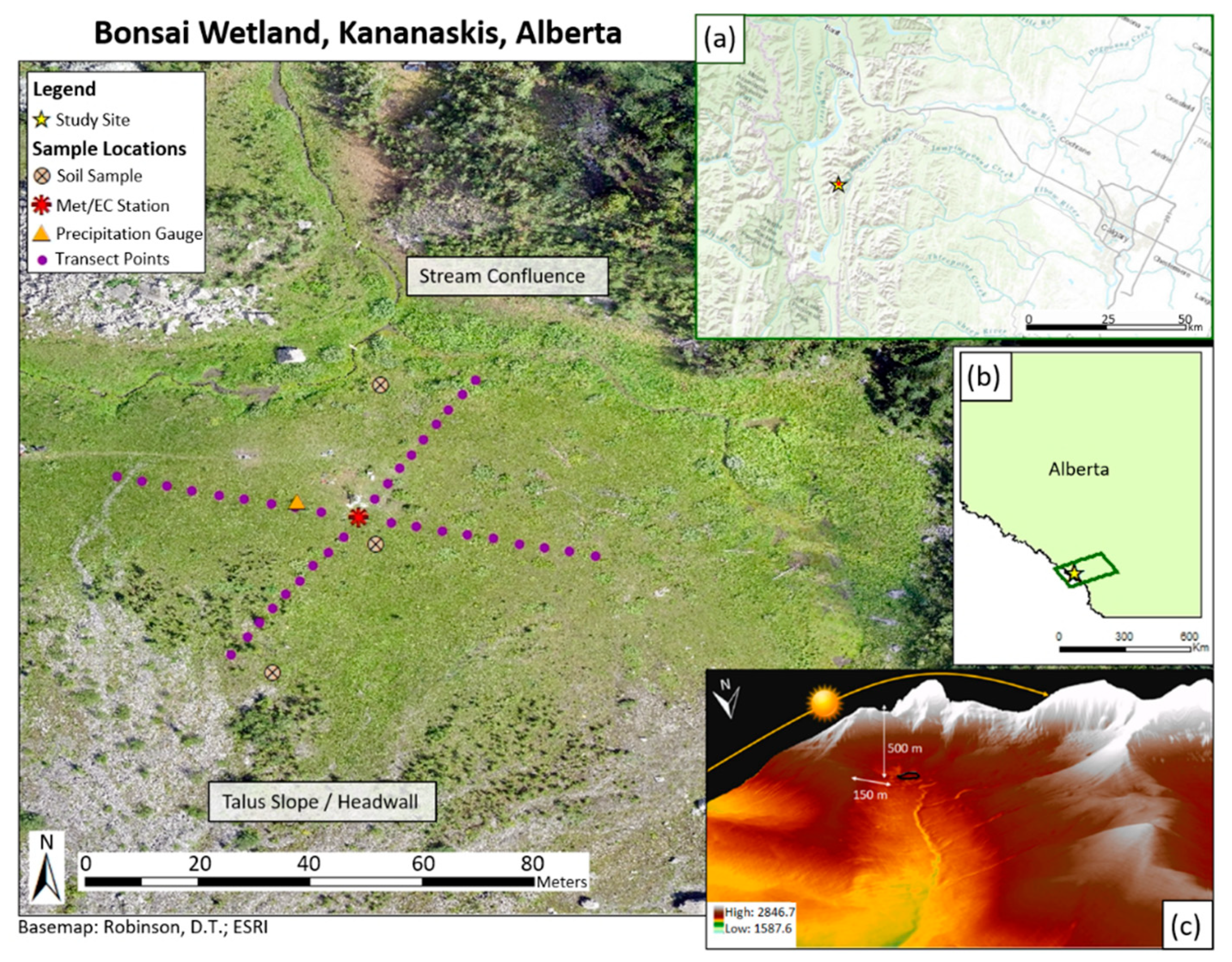

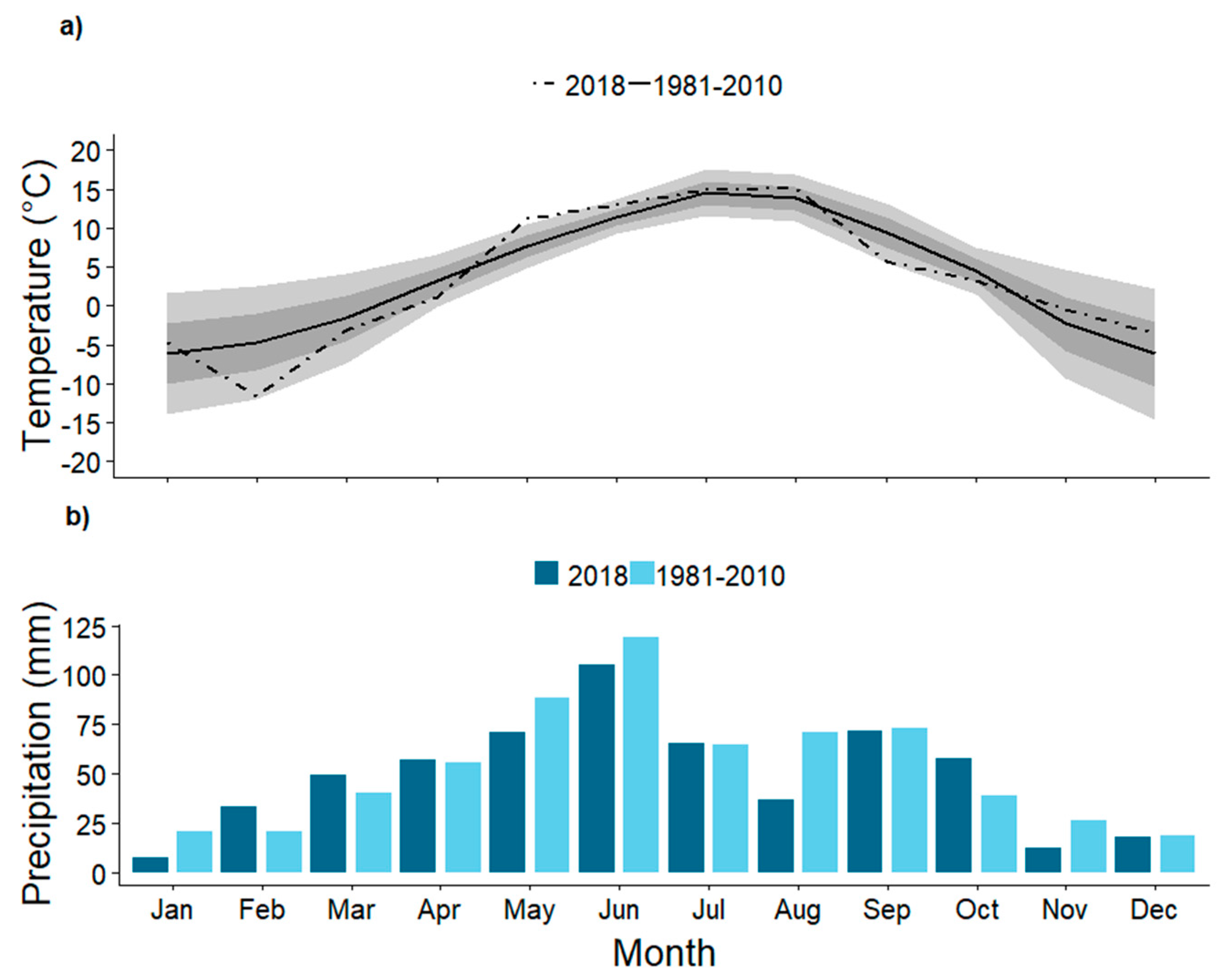




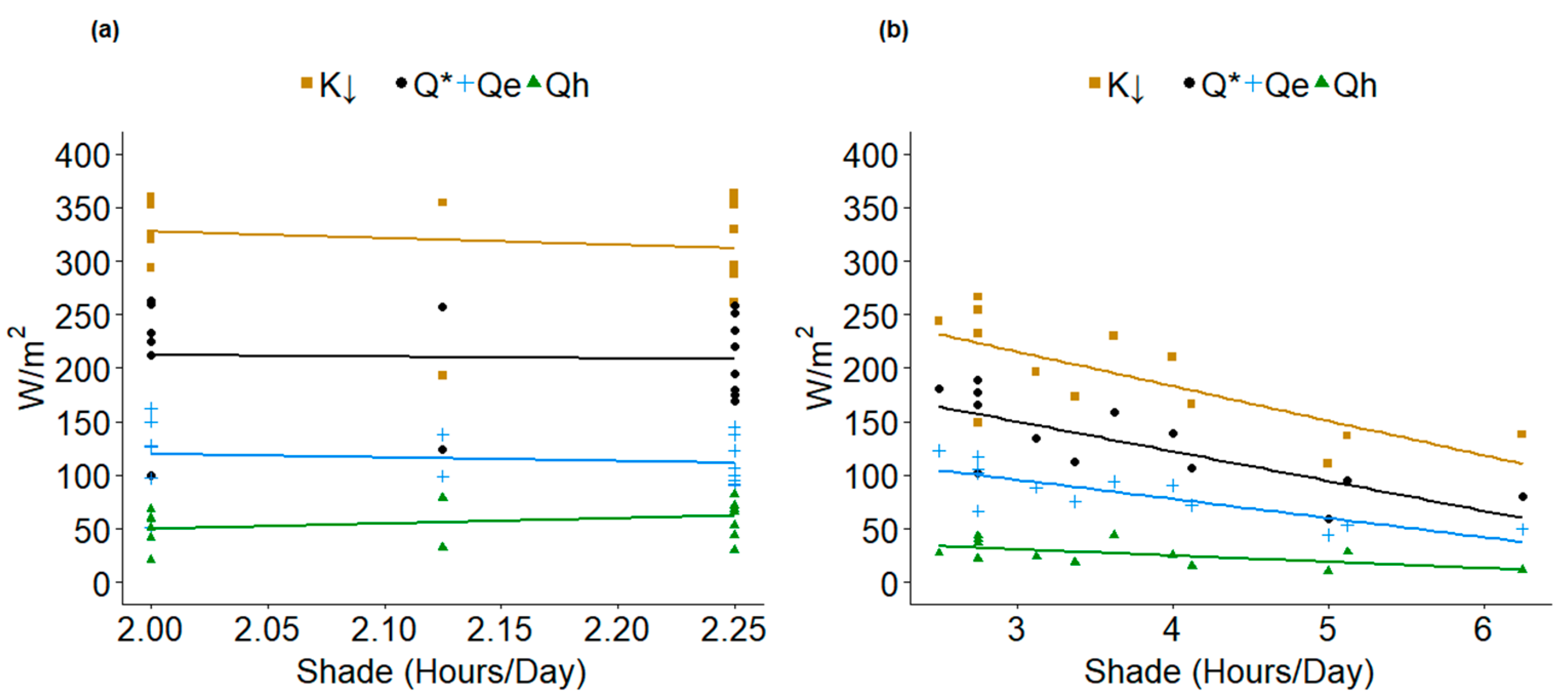
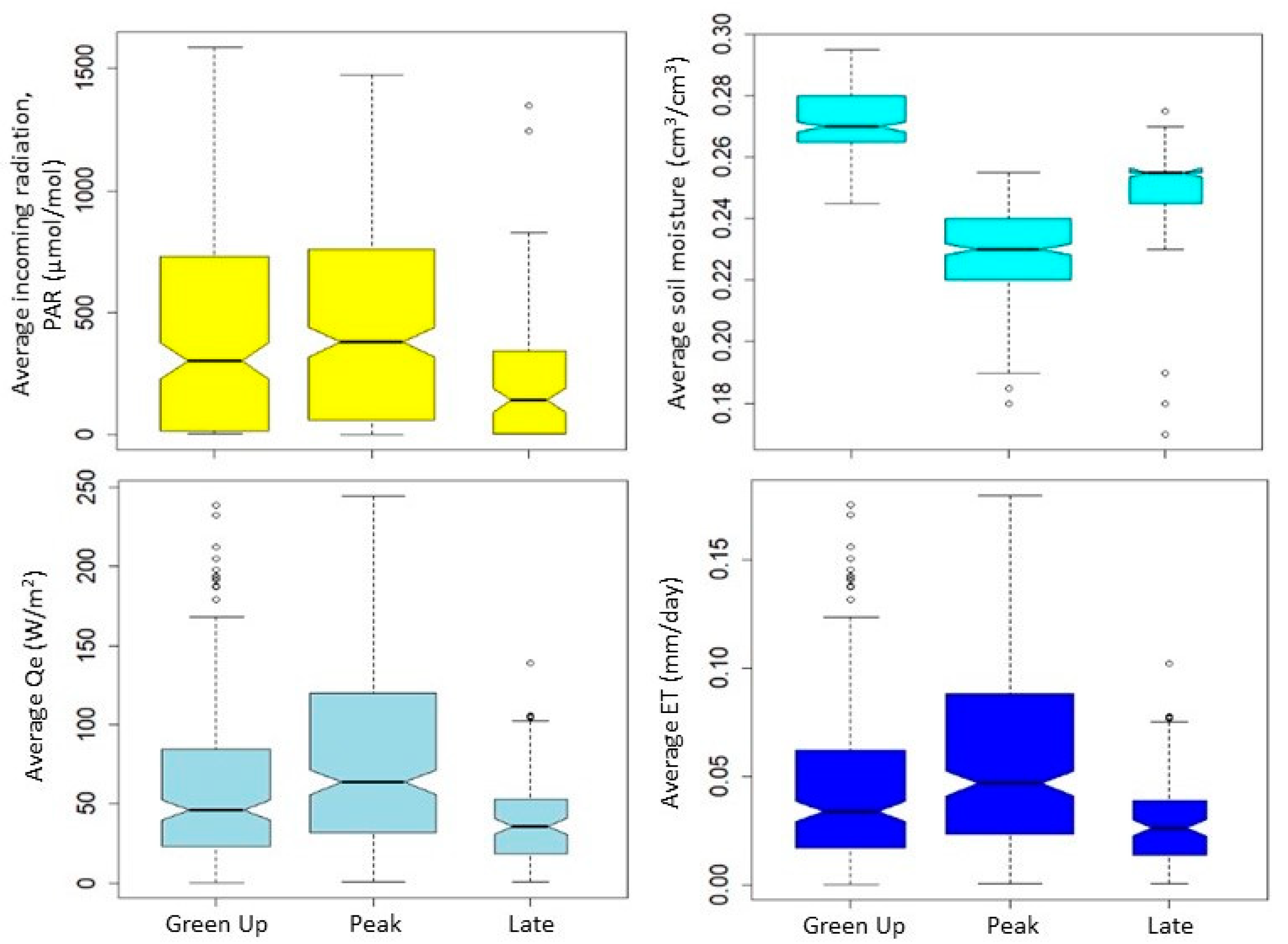
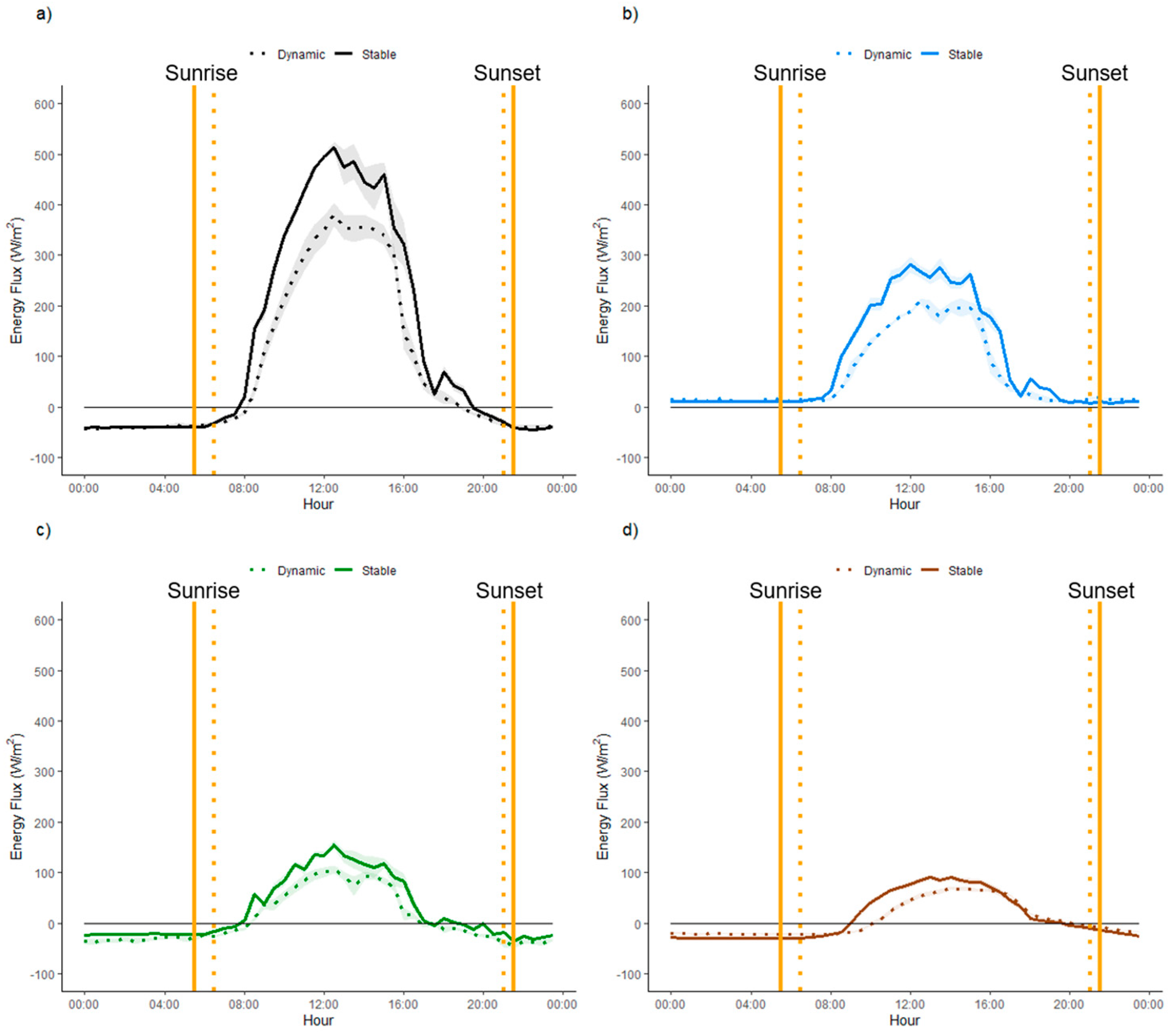
| K↓ | Q* | Qe | Qh | Qg | |
|---|---|---|---|---|---|
| Snow melt (7–23 June) | 336 (±35) | 191 (±79) | 93 (±34) | 47 (±19) | 26 (±41) |
| Green up (24 June–20 July) | 331 (±34) | 236 (±27) | 129 (±24) | 64 (±17) | 38 (±7) |
| Peak Growing season (21 July–23 Aug) | 219 (±42) | 151 (±35) | 98 (±19) | 32 (±11) | 25 (±6) |
| Late Growing Season (24 Aug–10 Sept) | 129 (±15) | 78 (±18) | 49 (±4) | 17 (±10) | 14 (±5) |
Publisher’s Note: MDPI stays neutral with regard to jurisdictional claims in published maps and institutional affiliations. |
© 2021 by the authors. Licensee MDPI, Basel, Switzerland. This article is an open access article distributed under the terms and conditions of the Creative Commons Attribution (CC BY) license (https://creativecommons.org/licenses/by/4.0/).
Share and Cite
Hrach, D.M.; Petrone, R.M.; Van Huizen, B.; Green, A.; Khomik, M. The Impact of Variable Horizon Shade on the Growing Season Energy Budget of a Subalpine Headwater Wetland. Atmosphere 2021, 12, 1473. https://doi.org/10.3390/atmos12111473
Hrach DM, Petrone RM, Van Huizen B, Green A, Khomik M. The Impact of Variable Horizon Shade on the Growing Season Energy Budget of a Subalpine Headwater Wetland. Atmosphere. 2021; 12(11):1473. https://doi.org/10.3390/atmos12111473
Chicago/Turabian StyleHrach, Dylan M., Richard M. Petrone, Brandon Van Huizen, Adam Green, and Myroslava Khomik. 2021. "The Impact of Variable Horizon Shade on the Growing Season Energy Budget of a Subalpine Headwater Wetland" Atmosphere 12, no. 11: 1473. https://doi.org/10.3390/atmos12111473
APA StyleHrach, D. M., Petrone, R. M., Van Huizen, B., Green, A., & Khomik, M. (2021). The Impact of Variable Horizon Shade on the Growing Season Energy Budget of a Subalpine Headwater Wetland. Atmosphere, 12(11), 1473. https://doi.org/10.3390/atmos12111473





